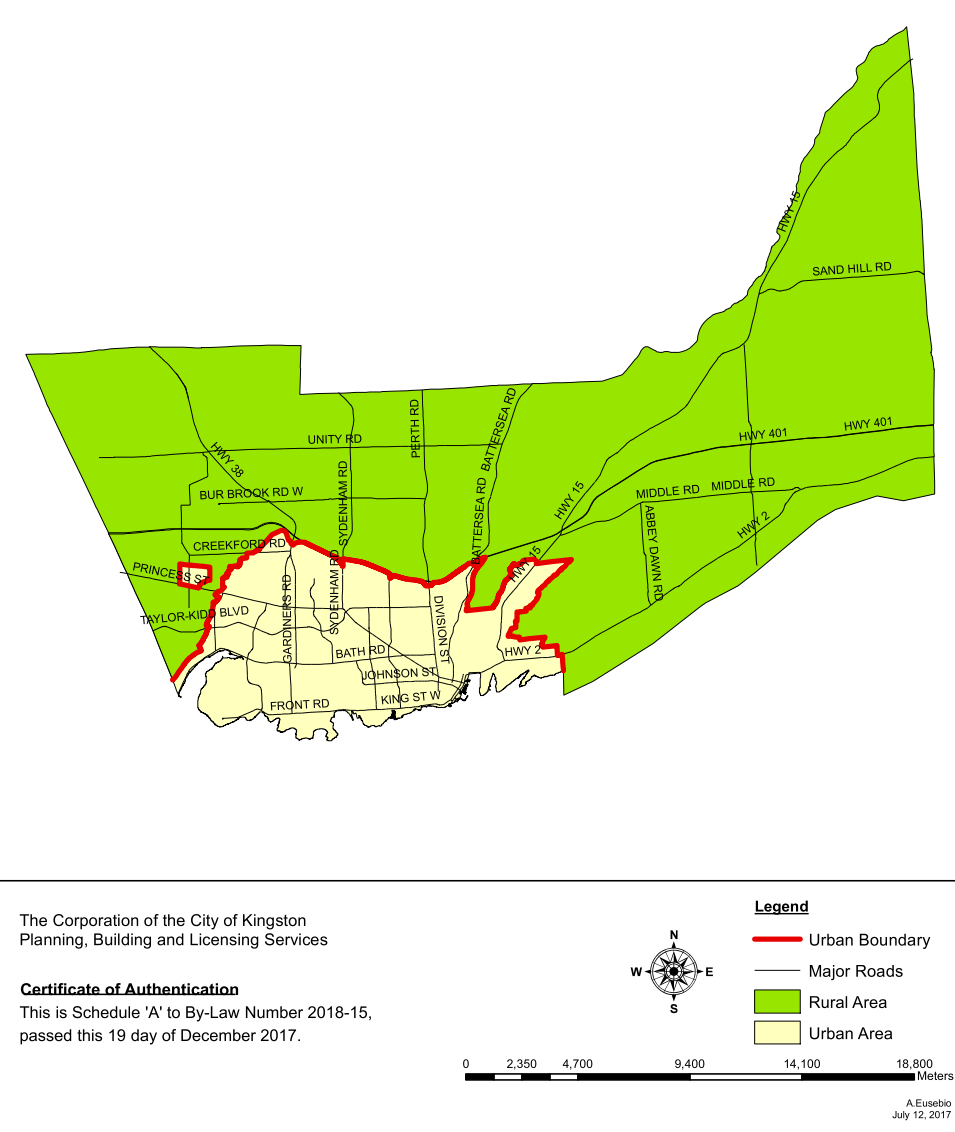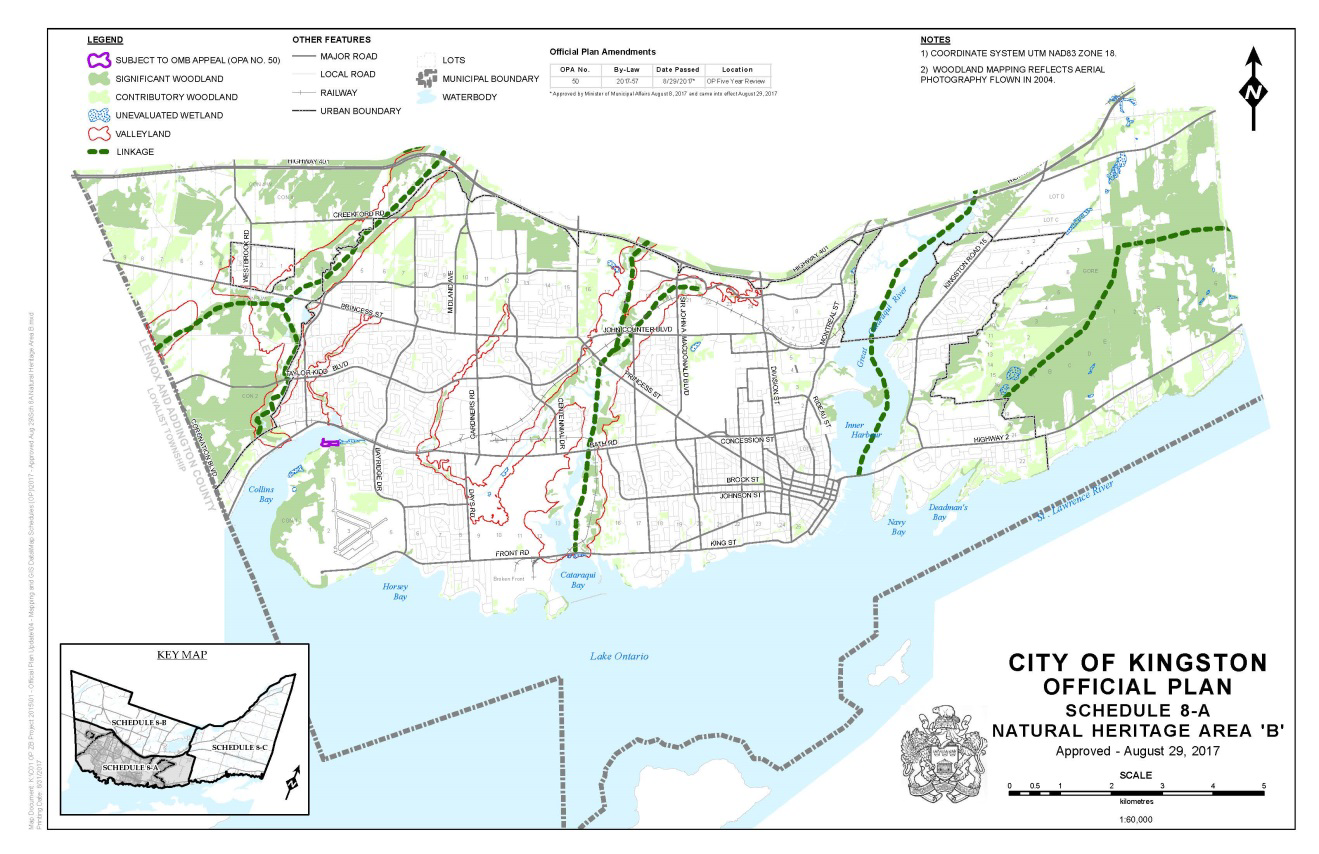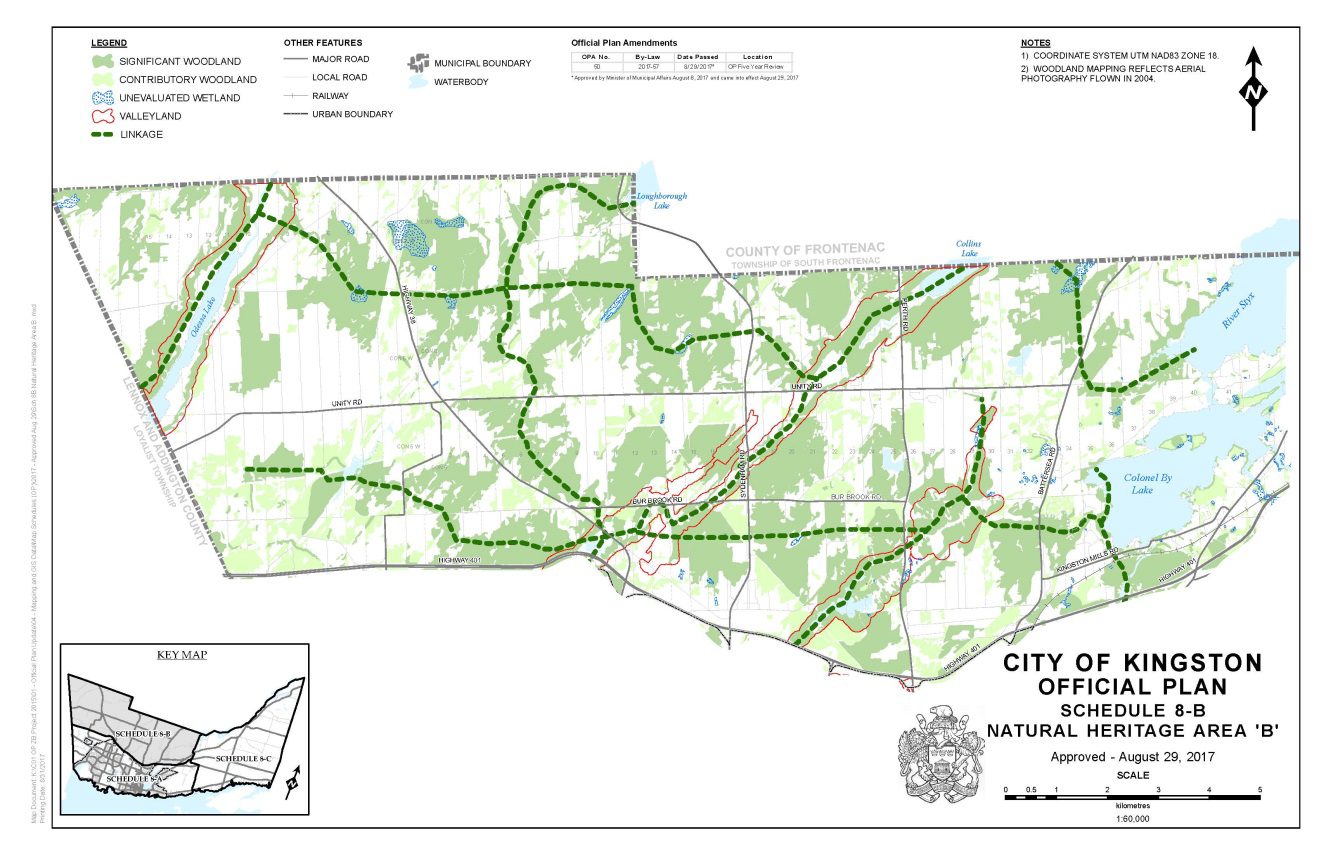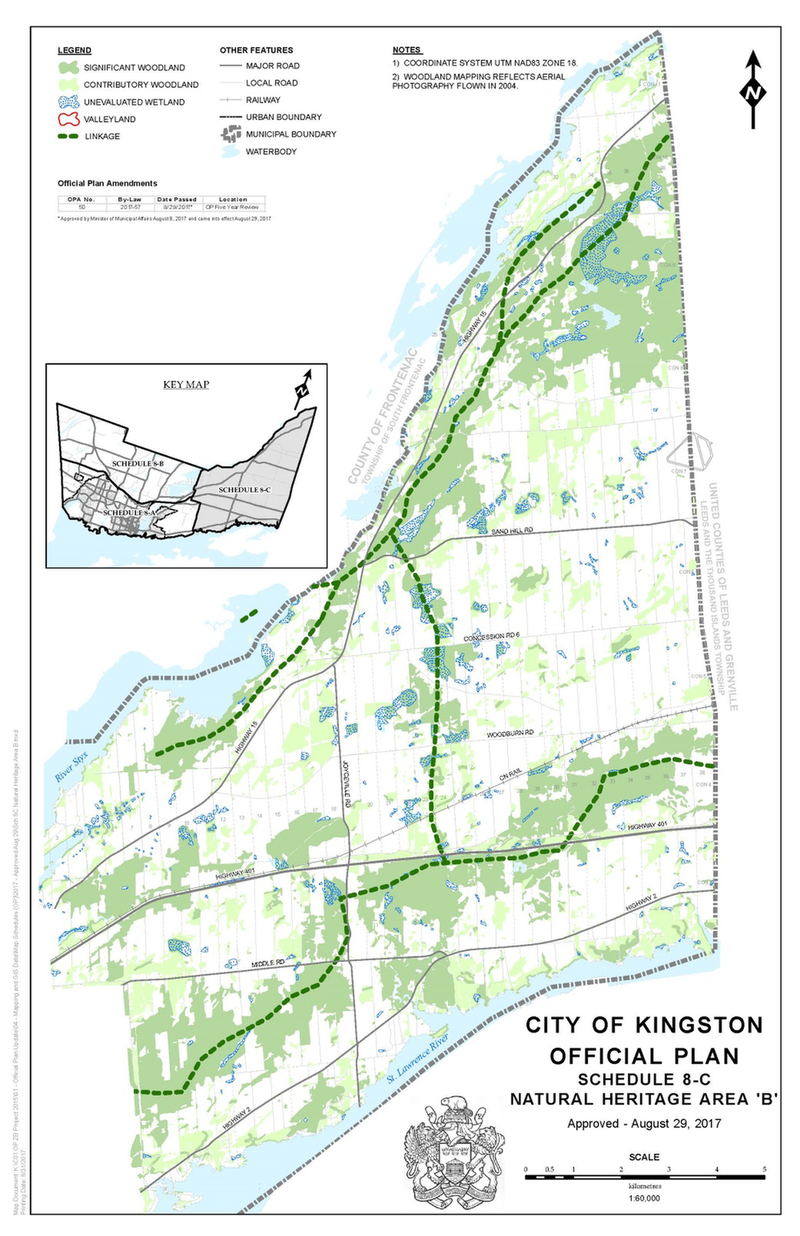For the purposes of this Bylaw:
Active Planning Application Property means a property that is known by the Director to be of interest for future development and/or subject to a development application under the Planning Act, and includes the following properties:
- A property subject to a pre-consultation application through the City of Kingston's Pre-Application process pursuant to Sections 22(3.1), 34(10.0.1), 41(3.1) and 51(16.1) of the Planning Act and any other voluntary pre-applications that have been received by the City indicating future development interest on a property, and such property will be deemed an Active Planning Application Property for a period of two years from the date of the issuance of the final Pre-Application Report from the City;
- A property subject to a site-specific application for an Official Plan amendment pursuant to Section 16, 17 and/or 22 of the Planning Act which has not yet received final approval from the Council of the City or the Minister of Municipal Affairs and Housing or the applicable approval authority, and such property will be deemed an Active Planning Application Property for a period of five years from the date of decision of such application;
- A property subject to a site-specific application for a zoning bylaw amendment pursuant to Section 34 of the Planning Act which has not yet received final approval and from the Council of the City or the applicable approval authority, and such property will be deemed an Active Planning Application Property for a period of five years from the date of decision of such application;
- A property subject to an application for site plan control approval pursuant to Section 41 of the Planning Act which has not yet obtained final approval from the Director or the applicable approval authority;
- A property subject to any application under Section 45 of the Planning Act which has not yet received a final and binding decision from the Committee of Adjustment or the applicable approval authority;
- A property subject to an application for part lot control pursuant to Section 50 of the Planning Act which has not yet received final approval from the Council of the City or the applicable approval authority;
- A property subject to an application for draft or final plan of subdivision, pursuant to Section 51 of the Planning Act which has not yet received final approval from the Council of the City or the applicable approval authority and/or a property that is subject to an approved draft plan of subdivision;
- A property subject to an application for consent pursuant to Section 53 of the Planning Act which has not yet received final approval from the Committee of Adjustment or the applicable approval authority;
- A property for which a Notice of Intent indicating interest in an urban boundary expansion request was submitted and identified in Exhibit D to Report Number 24-172;
- A property that was identified as "Vacant Lands – Committed Units", "Vacant Lands – Pending Units" or "Vacant Lands – No Applications" in Figure 18 of the Kingston Community Area Land Needs and Intensification Analysis prepared by Watson & Associates Economists Ltd., included in Report Number 24-172;
- A property that was considered for an Employment Area Conversion in Section 6 of the Kingston Employment Lands Review Final Report prepared by Watson & Associates Economists Ltd., included in Report Number 24-221;
- A property for which an Environmental Impact Assessment has been completed on behalf of the Owner and is under technical review by the City; and
- A property that is subject to a written request for additional development permissions during the new Official Plan project by the Owner or their authorized agent.
Administrative Penalty means an administrative penalty administered pursuant to "Bylaw 2020-69 of The Corporation of the City of Kingston being "A Bylaw to Establish a Process for Administrative Penalties
Agricultural Operation means land used for the commercial production of crops or raising of livestock and includes cultivation, seeding, and harvesting, but does not include Active Planning Application Properties where the nature of the planning application or stated development interest is not agricultural.
Applicant means a person who submits an application to the city for a Tree Permit pursuant to the provisions of this bylaw.
Building Permit means a Building Permit issued pursuant to the Building Code Act, 1992, SO 1992, c. 23.
Certified Arborist means an arborist certified by the Certification Board of the International Society of Arboriculture.
Certified Tree Marker means an individual who has full certification, and is in good standing, under the Ontario Ministry of Natural Resources and Forestry program for marking Trees.
City means The Corporation of the City of Kingston.
Clear Cutting means the removal of all Trees within a portion of a Woodland or a Significant Woodland where the area to be cleared is in excess of 0.2 hectare.
Closure Plan means a plan that outlines how the affected land will be rehabilitated and the costs associated with doing so with respect to the Mining Act.
Commercial Harvesting means the business of felling Trees and transporting logs to a market, with the expectation of financial gain or reward , but does not include Active Planning Application Properties where the nature of the planning application or stated development interest is not forestry related.
Cord means a pile of healthy, live wood that when stacked, measures 3.63 cubic metres (128 cubic feet) in volume.
Dead Tree means a Tree that has no living tissue as determined by a Qualified Person.
Designate means a person who is an employee of the city and who has been appointed by the Director to administer all or part of this Bylaw on behalf of the Director.
Destroy or "Destruction means any act that renders, or which is likely to render, a Tree unviable or compromise its life processes in such a way that it cannot survive.
Diameter at Breast Height (DBH) means the diameter of the trunk of a Tree measured in centimetres outside the bark at a point that is 1.37 metres above the ground.
Director means the Director of Planning, Building and Licensing Services or any successor position, and includes his or her Designate.
Diseased Tree means a sustained and progressive impairment of the structure or function of a Tree. Symptoms may include dieback, foliage discoloration, decay, galls, or wilting.
Distinctive Tree means a healthy Tree that is considered by the Director to be an uncommon species in the City of Kingston region and environment, or a Tree of an uncommon size, maturity or age, and includes, without limitation, those Tree species listed in Schedule 'A' to this Bylaw.
Ecological Function means the natural processes, products or services that living and non-living environments provide or perform within or between species, ecosystems and landscapes. These may include biological, physical and socio-economic interactions.
Emergency Work means any work required to be carried out immediately in order to prevent imminent danger to life, health or property from natural events (including lightning, wind, hail or an extreme snow event) or unforeseen circumstances (i.e. automobile accidents), and includes work of an urgent nature which can be associated with drain repairs, utility repairs or structural repairs to a building, and work required to prevent soil erosion, slipping of soil or damage to Trees.
Environmental Impact Assessment (EIA) means an analysis performed by a Qualified Person with current knowledge in the field of biology, ecology, hydrology or other specialty as required by specific circumstances that inventories and assesses the potential impact of a development on Natural Heritage Features and Areas, and their Ecological Function and makes recommendations for measures to ensure that the proposed development has no Negative Impacts on those features and areas and their Ecological Functions.
Environmental Protection Areas means areas of natural and scientific interest (ANSIs), fish habitat or significant wildlife habitat areas, provincially significant wetlands, significant coastal wetlands and locally significant wetlands, rivers, streams and small inland lake systems and the Snake and Salmon Islands, located in Lake Ontario, all of which are shown in the City of Kingston Official Plan.
Forest Management Plan means a document, including prescriptions for Silviculture and ecological conservation, prepared by a Registered Professional Forester on behalf of an Owner for the purpose of managing natural and forestry resources in accordance with Good Forestry Practices.
Good Arboricultural Practice means the proper planting and care of Trees in accordance with the standards set by the International Society of Arboriculture.
Good Forestry Practice means the proper implementation of harvest, renewal, and maintenance activities known to be appropriate for forest and environmental conditions under which they are being applied that minimize detriments to forest values, including significant ecosystems, important fish and wildlife habitat, soil and water quality and quantity, forest productivity and health;
Hazard Tree means a Tree that is severely damaged to the extent that it poses an immediate safety threat to Persons or property.
Injure or Injury means any action that causes physical, biological, or chemical harm or damage to a Tree.
Landscaping, Replanting and Replacement Plan means a plan which identifies the number, location, species and size of existing Trees, Trees to be planted or replaced and other landscaping elements on a property and provides details regarding planting methodology and timing.
Natural Heritage Features and Areas means features and areas, including significant wetlands, significant coastal wetlands, other coastal wetlands, fish habitat, waters supporting aquatic species at risk, Significant Woodlands, significant valleylands, significant habitat of endangered species and threatened species, significant wildlife habitat, and significant areas of natural and scientific interest, which are important for their environmental and social values as a legacy of the natural landscapes of an area.
Negative Impacts means in regards to Natural Heritage Features and Areas, degradation that threatens the health and integrity of the natural features or Ecological Functions for which an area is identified due to single, multiple or successive development or Site Alteration activities.
Officer means an individual appointed by the City to enforce the provisions of this Bylaw, and includes a municipal bylaw enforcement officer.
Official Plan means the City of Kingston Official Plan, being a land use document that sets out the goals, objectives and policies established primarily to manage and direct physical change and the effects of such change on the social, economic and natural environment of the municipality.
Normal Farm Practice means a practice, as defined in the Farming and Food Production Protection Act, 1998, SO 1998, c. 1, that is conducted in a manner consistent with proper and acceptable customs and standards as established and followed by similar agricultural operations under similar circumstances or a practice which makes use of innovative technology in a manner consistent with proper advanced farm management practices, but does not include Active Planning Application Properties where the nature of the planning application or stated development interest is not agricultural or farming related.
Open Space means areas in the municipality designated Open Space in the City of Kingston Official Plan, which include public parks, private open space areas, and natural reserves.
Owner means the Person(s) registered on the title of the land in the Land Registry Office.
Penalty Notice means a notice given pursuant to sections 2.2 and 2.4 of "Bylaw 2020-69 of The Corporation of the City of Kingston being "A Bylaw to Establish a Process for Administrative Penalties.
Person means an individual, firm, corporation, association or partnership.
Personal Use means the utilization of a Tree, Trees or Tree sections Destroyed or Injured and collected solely for the Owner's use (e.g. fuel wood) and includes the accessory sale of no more than three (3) Cords of wood within a consecutive period of twelve (12) months, but does not include Active Planning Application Properties where the nature of the planning application or stated development interest is not related to the development being a personal residence for the Owner.
Pruning means the removal, as appropriate, of not more than one-third the live branches or limbs of a tree in accordance with Good Arboricultural Practice.
Plant Nursery means the use of land, buildings or structures, or portions thereof, where Trees, shrubs or other plants are grown for the purpose of retail or wholesale trade. A Plant Nursery may include the accessory sale of soil, planting materials, fertilizers, garden equipment, ornaments and similar material, but does not include Active Planning Application Properties where the nature of the planning application or stated development interest is not related to the retail or wholesale trade of trees, shrubs and plants.
Qualified Person means an individual with qualifications and/or credentials related to a field of study and who is therefore appropriate for conducting a study and/or providing an expert opinion that has been required by the City. The qualifications and credentials of the Qualified Person must be to the satisfaction of the City, or where appropriate, may be defined by relevant legislation, regulations and standards.
Registered Professional Forester means a member of the Ontario Professional Foresters Association as defined in the Professional Foresters Act, 2000, SO 2000, c. 18.
Residential Unit means a unit that consists of a self-contained set of rooms located in a building or structure, used or intended for use as a residential premises and contains a kitchen and bathroom facilities that are exclusive to the users of the unit.
Rural Area means the area located outside of the Urban Boundary, as shown in the City of Kingston Official Plan as indicated in Schedule 'B' of this Bylaw.
Selective Harvesting means the selective removal of trees, undertaken in accordance with Good Arboricultural Practices and Good Forestry Practices, that allows for regrowth and does not result in Clear Cutting, but does not include Active Planning Application Properties where the nature of the planning application or stated development interest is not related to forestry.
Significant Woodlands means an area shown in the City of Kingston Official Plan and indicated on Schedule 'C' of this Bylaw. Significant Woodlands have been identified through the Central Cataraqui Region Natural Heritage Study (2006) or identified using criteria established by the Ontario Ministry of Natural Resources and Forestry which are ecologically important in terms of features such as species composition, age of trees and stand history; functionally important due to its contribution to the broader landscape because of its location, size or the amount of forest cover in the planning area; or economically important due to site quality, species composition, or past forest management history.
Silviculture means the theory and practice of growing and cultivating trees to achieve the objectives of forest management.
Silvicultural Prescription means the site specific operational plan, signed and sealed by a Certified Arborist that describes the existing forest conditions and the forest management objectives for an area, and which prescribes the methods for harvesting the existing forest stand and a series of silvicultural treatments that will be carried out to establish a free-growing stand in a manner that accommodates other resource values as identified.
Site Alteration means activities, such as grading, excavation and the placement of fill that change the landform and natural vegetative characteristics of a site.
Tree means any species of woody perennial plant, including its root system, which has reached or can reach a height of at least 4.5 metres at physiological maturity.
Tree Permit means the formal written approval from the Director to Destroy or Injure Trees, with or without conditions.
Tree Preservation and Protection Plan means a plan prepared by a Certified Arborist and approved by the Director, that includes measures required to eliminate or mitigate the potential risk of Tree damage.
Tree Protection Zone means an area surrounding a Tree that is marked and fenced off, where storage of materials of any kind, parking or moving of vehicles, and disturbance of the soil or grade is prohibited.
Urban Area means the area within the Urban Boundary as defined in the Official Plan as indicated on Schedule 'B' of this Bylaw.
Urban Boundary means lands on full municipal services as defined in the Official Plan and indicated on Schedule 'B' of this Bylaw.
Woodlands means treed areas that provide environmental and economic benefits to both the private landowner and the general public, such as erosion prevention, hydrological and nutrient cycling, provision of clean air and the long-term storage of carbon, provision of wildlife habitat, outdoor recreational opportunities, and the sustainable harvest of a wide range of woodland products, and that have a quantity of Trees of a specific size as defined in the Forestry Act, RSO 1990, c F.26, that is more than one (1) hectare in area.

 image
image





